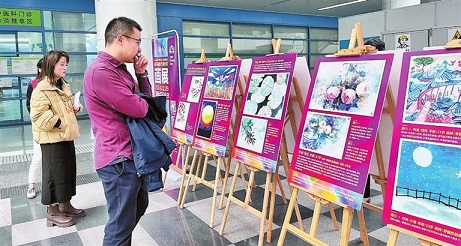Shenzhen
 2024/2/27
2024/2/27
 source: Shenzhen Daily
source: Shenzhen Daily
 Print
Print

Visitors look at poster boards that include artwork created by rare disease patients and information about the rare diseases they are treated for at an event held in the atrium of the Outpatient and Medical Services Block in HKU-SZH yesterday. Zhang Yu
Zhang Yu
JeniZhang13@163.com
A NUMBER of patients with rare diseases from the mainland and Hong Kong attended a charitable event at The University of Hong Kong-Shenzhen Hospital (HKU-SZH) yesterday, two days ahead of Rare Disease Day. The event also marked the launch of an art exhibition featuring the work of rare disease patients.
Rare Disease Day, observed annually on the last day of February, is the official awareness-raising campaign for rare diseases.
The event was jointly organized by the Shenzhen hospital, multiple charitable foundations, and patient organizations, and it included interdisciplinary health consultation on rare diseases, science popularization, and the “Share Your Colors” art exhibition that will run for a week.
“It is aimed at raising public awareness and arousing more care from all sectors of society towards rare diseases and the problems faced by people with rare diseases,” Michael To, director of the Orthopedic Center at HKU-SZH, told Shenzhen Daily.
According to To, rare diseases are one of the biggest health challenges faced by humans, and approximately 80% of rare diseases are caused by genetic defects. At present, there are about 7,000 confirmed rare diseases worldwide that account for approximately 10% of total human diseases.
As a key hospital in treating rare diseases in Shenzhen, HKU-SZH undertook the city’s first key rare disease project in 2020, according to the hospital.
It has also introduced four rare disease medicines and medical devices through the “Hong Kong and Macao Medicine and Equipment Connect” policy for patient treatment on the mainland.
Earlier this year, the hospital joined forces with a multidisciplinary medical team for rare diseases, led by Professor Zhang Shuyang from Peking Union Medical College Hospital, to carry out cooperation in medicine, education, research, and prevention as well as to improve the diagnosis and treatment of rare diseases.





